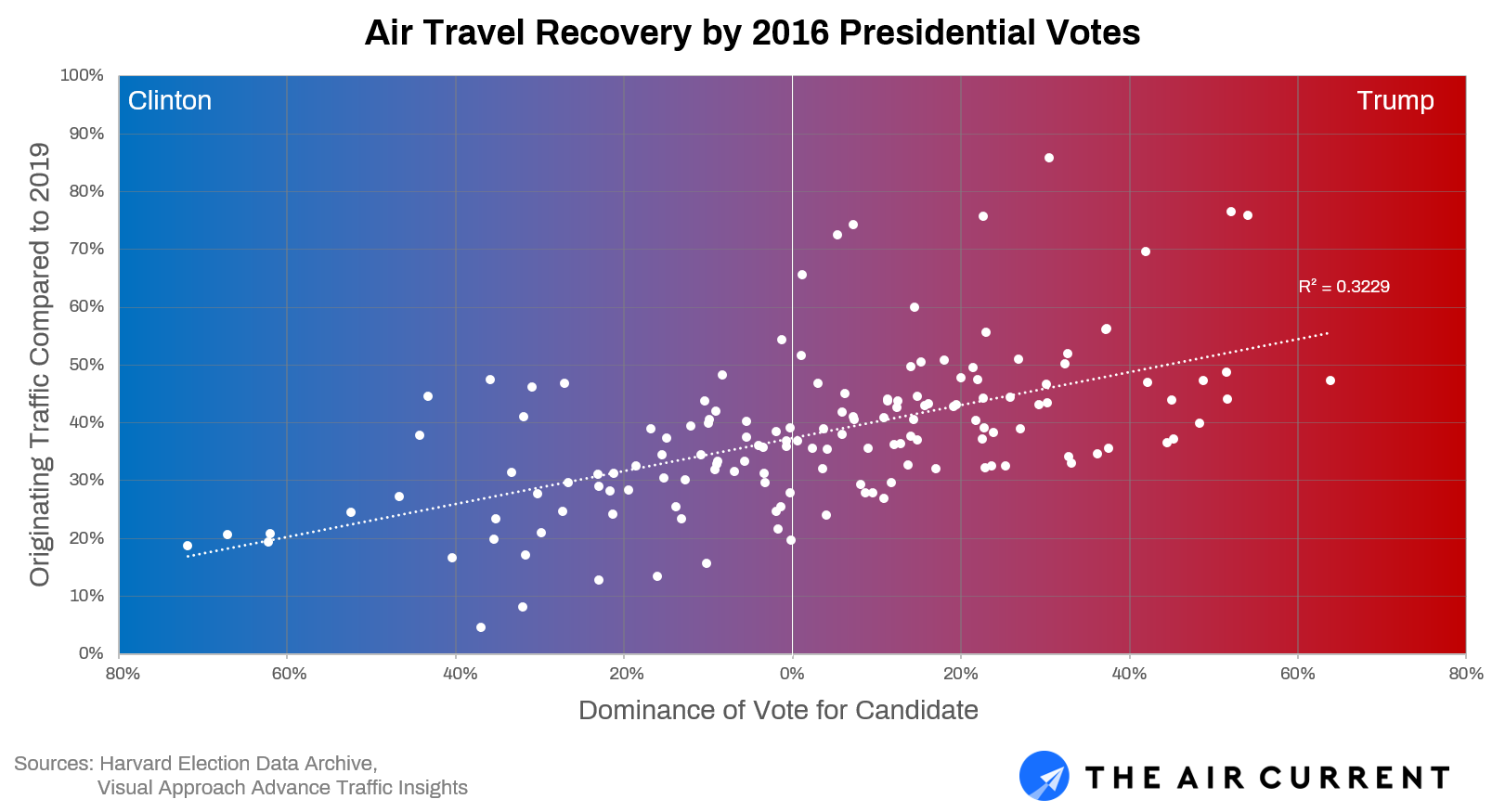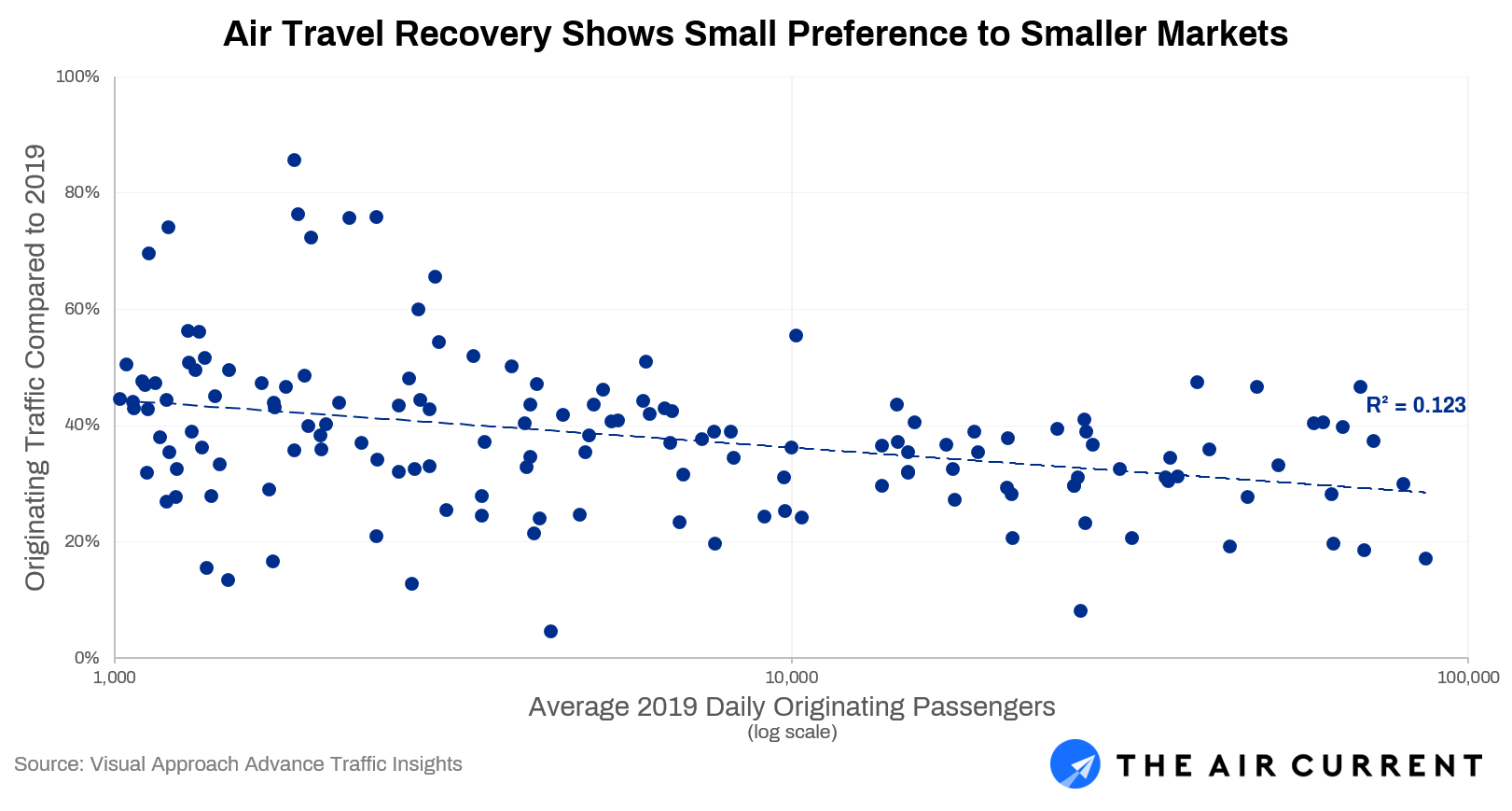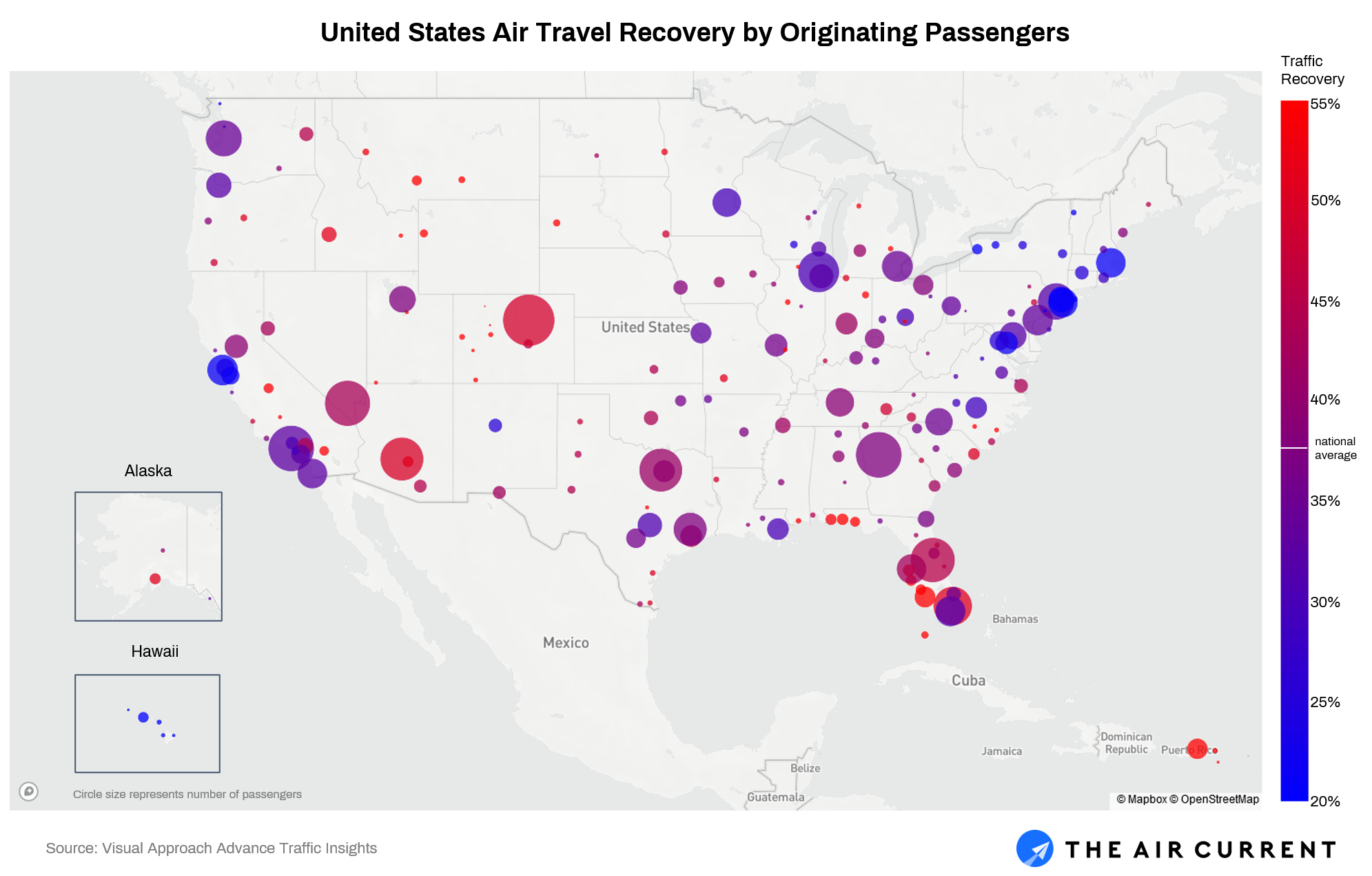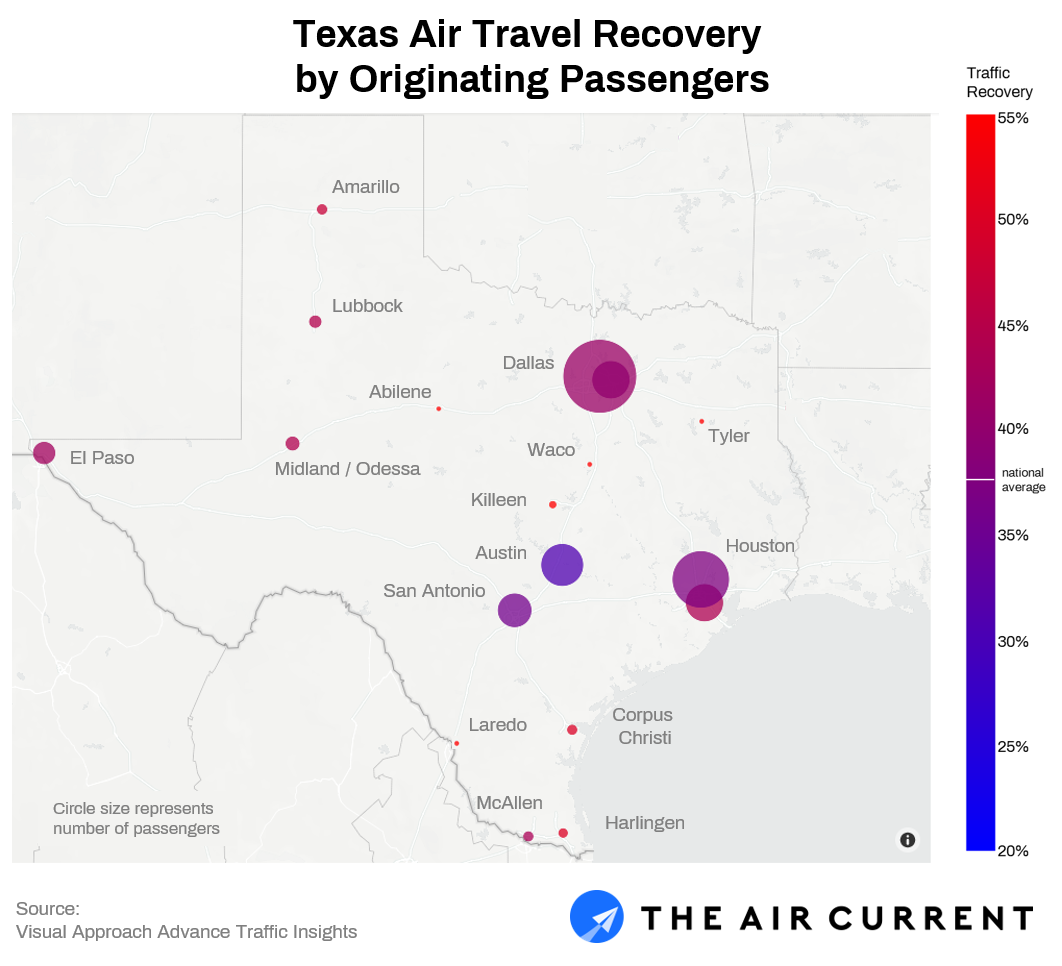Americans have their last opportunity on Nov. 3 to cast a ballot in the 2020 general election in a country as polarized as it has been in generations, only amplified by a pandemic.
For the U.S. airlines, already mired in the fallout from COVID-19, local political affiliation appears to be playing a key role in the air travel rally today. Research conducted by TAC Analysis has uncovered a distinct trend of air travel recovery dependent upon how the local voters cast their ballots in the 2016 general election.
Subscribe to TACUsing Visual Approach’s Advance Traffic Insights, showing detailed airport traffic recovery statistics with data as recent as Oct. 17, a correlation appears between a region’s political affiliation and its willingness to return to the skies.
Related: Breaking the statistical link between COVID-19 cases and air travel demand
By comparing county voter ballots cast in 2016 to traffic at the closest commercial airport, a correlation emerges suggesting communities with Republican voters are more quickly returning to travel by air than their Democratic counterparts.

As the margin of Democratic votes approaches 80% of the local population, the local airport’s passenger numbers average just 20% of what they were during the same week one year ago. This is compared to over 60% for similarly Republican dominated regions – a 40 point swing in the local population’s propensity to travel amid the pandemic. This compares to a current year-over-year national average of 37%.
The data shows a strong support of what was long expected to be true: Republican voters are currently more likely to return to the skies than their Democratic counterparts.
Yet, in a dutiful reminder, correlation does not mean causation. In short, political affiliation does not cause aviation — and vice versa. Nor does it consider any social or health-related effects traveling during a global pandemic may bring.
Related: Six months into the pandemic, it’s even worse for airlines than we thought
While the 0% mid-point (dominance of vote for candidate) has been derived from the 2016 presidential contest — Donald Trump v. Hillary Clinton — the return of air travel does not indicate the midpoint of the 2020 election. Crucially, air travel recovery is no indication of anticipated 2020 election results.
Several factors exist beyond political affiliation which are likely to have some connection to the correlation with traffic recovery. For instance, Democratic voters tend to be concentrated into large cities, while less-densely populated areas tend to lean more conservative toward Republican votes.
This political relation to population density also happens to coincide with the threat of infection spread, where densely populated areas pose a much higher risk of infection than those areas which are more sparsely populated.
Further, public health initiatives more often advanced by left-leaning municipalities and state governors may have had a chilling effect on travel in general. Conversely, in some right-leaning communities where there has been a rejection of mask-wearing mandates and social distancing, closures, etc. the policy decisions have likely had the opposite effect. In this way, observationally, the willingness to get out and about in the world has also translated to flying.

In fact, the data does show a correlation between market size and air travel recovery, albeit at much lower levels.
This suggests that, whether it be from local presence of the infection or a larger portion of the typical travel being slower to recover business-related, the larger the city, the slower the travel recovery.
Further to the size of the market and its local airport’s catchment area is its geographical location. With Clinton performing well in 2016 on the country’s east and west coasts, this also coincides with markets typically dependent upon more international travel which, amid wide-spread travel restrictions has yet to show any meaningful recovery.
Read: 737 Max recertification risks becoming pawn in U.S.-China fight
According to the data, the U.S. traffic recovery is strongest through the middle of the country, potentially due to being positioned closer to more domestic destinations compared to its coastal counterparts. Yet, outliers appear, particularly in Florida and Puerto Rico, both markets largely dependent on inbound leisure travel, where vacationing passengers through the airport are less likely to be local voters.

The Islands
Puerto Rico, in particular, remains notable as a territory unable to cast ballots for presidential elections, and has historically shown a strong politically left-leaning tendency. Despite this, the island territory has seen strong traffic recovery as inbound leisure travelers eclipse liberal outbound residents.
For Hawaii, however, the staunchly Democratic state also remains the laggard in recovery, with less than 10% of 2019 passengers returning to the islands. To be certain, the state’s strict quarantine guidelines are a driving factor in limiting travel to the islands. However it cannot be ignored that the guidelines are also a result of the local government policy, which by definition, is inherently influenced by politics.
Subscribe to TACA positive sign for the island state, quarantine restrictions were recently lifted for much of Hawaii, replaced by a testing requirement similar to Puerto Rico in hopes to lure travelers back to the islands.
Yet, even when adjusted for other factors, the ballots cast in 2016 for President of the United States still hold a meaningful predictor for how a region’s air travel will have recovered to this point in 2020. This is most apparent in the state of Texas, a typically red state with a deeply blue population center in Austin.

Even as the smaller cities of Texas show strong recoveries similar to other small communities across the country, the differences between the state’s four largest cities clearly shows the political effects on air travel.
Left-leaning Austin significantly lags the recovery of its sibling cities of Dallas, Houston, and San Antonio. With 63% of the 2016 ballots cast for Hillary Clinton, Austin and its surrounding counties has recovered only 30% of its 2019 originating passengers. This is compared with 36% for San Antonio, 37% and 41% for Dallas Love Field and Dallas/Ft. Worth airports, respectively, 37% for Houston Intercontinental George Bush and 44% recovery for Houston Hobby airport. (Even though large hubs in Houston and Dallas move more connecting traffic, the study is limited to originating passengers only, providing an accurate view of local activity).
Related: U.S. airlines are having a knife fight on a life raft
Even outside Austin, the trend holds as higher levels of 2016 votes for Clinton results in lower levels of 2020 traffic recovery. The data shows this trend continues across the entire country, as passengers weigh returning to air travel in the midst of a pandemic.
Whatever the reason, there remains a strong correlation between a region’s political leaning and the local populations willingness to return to the skies. For the United States, bristling with political partisanship at record levels, there seems to be no escape from the divide — including in the sky.
Write to Courtney Miller at courtney@theaircurrent.com
Subscribe to Continue Reading
Our award-winning aerospace reporting combines the highest standards of journalism with the level of technical detail and rigor expected by a sophisticated industry audience.
- Exclusive reporting and analysis on the strategy and technology of flying
- Full access to our archive of industry intelligence
- We respect your time; everything we publish earns your attention

